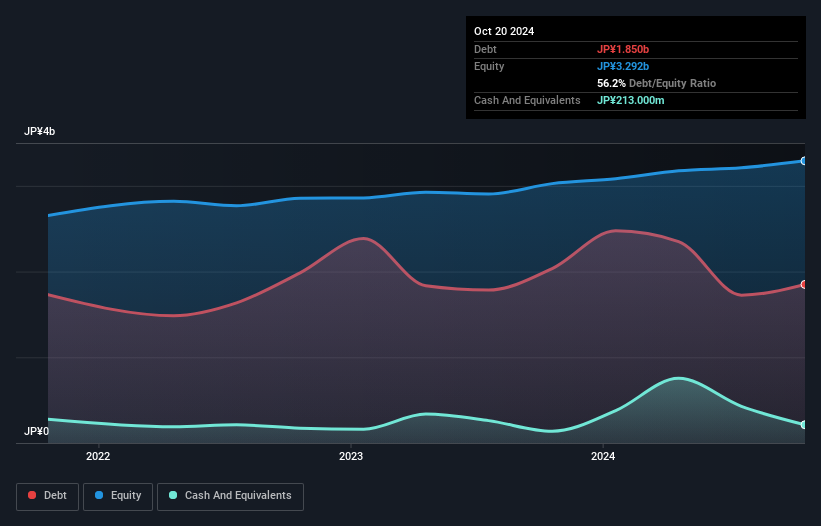
David Iben put it well when he said, 'Volatility is not a risk we care about. What we care about is avoiding the permanent loss of capital.' So it seems the smart money knows that debt - which is usually involved in bankruptcies - is a very important factor, when you assess how risky a company is. We note that KITAC Corporation (TSE:4707) does have debt on its balance sheet. But is this debt a concern to shareholders?
When Is Debt A Problem?
Debt assists a business until the business has trouble paying it off, either with new capital or with free cash flow. Part and parcel of capitalism is the process of 'creative destruction' where failed businesses are mercilessly liquidated by their bankers. However, a more frequent (but still costly) occurrence is where a company must issue shares at bargain-basement prices, permanently diluting shareholders, just to shore up its balance sheet. Having said that, the most common situation is where a company manages its debt reasonably well - and to its own advantage. The first thing to do when considering how much debt a business uses is to look at its cash and debt together.
See our latest analysis for KITAC
What Is KITAC's Debt?
The image below, which you can click on for greater detail, shows that KITAC had debt of JP¥1.85b at the end of October 2024, a reduction from JP¥2.04b over a year. However, because it has a cash reserve of JP¥213.0m, its net debt is less, at about JP¥1.64b.

How Healthy Is KITAC's Balance Sheet?
Zooming in on the latest balance sheet data, we can see that KITAC had liabilities of JP¥2.21b due within 12 months and liabilities of JP¥564.0m due beyond that. Offsetting these obligations, it had cash of JP¥213.0m as well as receivables valued at JP¥176.0m due within 12 months. So it has liabilities totalling JP¥2.38b more than its cash and near-term receivables, combined.
Given this deficit is actually higher than the company's market capitalization of JP¥2.21b, we think shareholders really should watch KITAC's debt levels, like a parent watching their child ride a bike for the first time. In the scenario where the company had to clean up its balance sheet quickly, it seems likely shareholders would suffer extensive dilution.
In order to size up a company's debt relative to its earnings, we calculate its net debt divided by its earnings before interest, tax, depreciation, and amortization (EBITDA) and its earnings before interest and tax (EBIT) divided by its interest expense (its interest cover). Thus we consider debt relative to earnings both with and without depreciation and amortization expenses.
KITAC has a debt to EBITDA ratio of 3.4, which signals significant debt, but is still pretty reasonable for most types of business. However, its interest coverage of 1k is very high, suggesting that the interest expense on the debt is currently quite low. Notably, KITAC's EBIT launched higher than Elon Musk, gaining a whopping 190% on last year. When analysing debt levels, the balance sheet is the obvious place to start. But it is KITAC's earnings that will influence how the balance sheet holds up in the future. So when considering debt, it's definitely worth looking at the earnings trend. Click here for an interactive snapshot.
Finally, a business needs free cash flow to pay off debt; accounting profits just don't cut it. So the logical step is to look at the proportion of that EBIT that is matched by actual free cash flow. Over the last three years, KITAC recorded negative free cash flow, in total. Debt is far more risky for companies with unreliable free cash flow, so shareholders should be hoping that the past expenditure will produce free cash flow in the future.
Our View
While KITAC's conversion of EBIT to free cash flow has us nervous. To wit both its interest cover and EBIT growth rate were encouraging signs. Taking the abovementioned factors together we do think KITAC's debt poses some risks to the business. While that debt can boost returns, we think the company has enough leverage now. When analysing debt levels, the balance sheet is the obvious place to start. However, not all investment risk resides within the balance sheet - far from it. Be aware that KITAC is showing 3 warning signs in our investment analysis , and 1 of those is concerning...
If you're interested in investing in businesses that can grow profits without the burden of debt, then check out this free list of growing businesses that have net cash on the balance sheet.
Valuation is complex, but we're here to simplify it.
Discover if KITAC might be undervalued or overvalued with our detailed analysis, featuring fair value estimates, potential risks, dividends, insider trades, and its financial condition.
Access Free AnalysisHave feedback on this article? Concerned about the content? Get in touch with us directly. Alternatively, email editorial-team (at) simplywallst.com.
This article by Simply Wall St is general in nature. We provide commentary based on historical data and analyst forecasts only using an unbiased methodology and our articles are not intended to be financial advice. It does not constitute a recommendation to buy or sell any stock, and does not take account of your objectives, or your financial situation. We aim to bring you long-term focused analysis driven by fundamental data. Note that our analysis may not factor in the latest price-sensitive company announcements or qualitative material. Simply Wall St has no position in any stocks mentioned.
About TSE:4707
Good value with acceptable track record.
Similar Companies
Market Insights
Community Narratives




